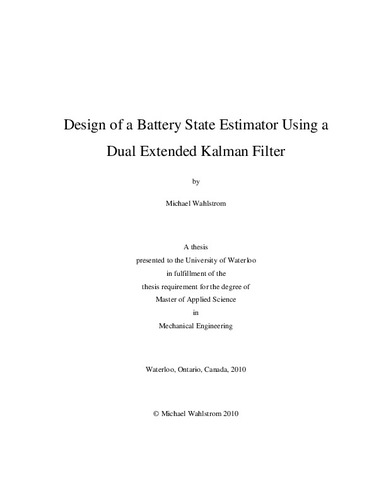| dc.contributor.author | Wahlstrom, Michael | |
| dc.date.accessioned | 2011-02-14 15:09:10 (GMT) | |
| dc.date.available | 2011-02-14 15:09:10 (GMT) | |
| dc.date.issued | 2011-02-14T15:09:10Z | |
| dc.date.submitted | 2010 | |
| dc.identifier.uri | http://hdl.handle.net/10012/5790 | |
| dc.description.abstract | Today's automotive industry is undergoing significant changes in technology due to economic, political and environmental pressures. The shift from conventional internal combustion vehicles to hybrid and plug in hybrid electric vehicles brings with it a new host of technical challenges. As the vehicles become more electrified, and the batteries become larger, there are many difficulties facing the battery integration including both embedded control and supervisory control. A very important aspect of Li-Ion battery integration is the state estimation of the battery. State estimation can include multiple states, however the two most important are the state of charge and state of health of the battery. Determining an accurate state of charge estimation of a battery has been an important part of consumer electronics for years now [1]. In small portable electronics, the state of charge of the battery is used to determine the time remaining on the current battery charge. Although difficult, the estimation is simplified by the relatively low charge and discharge currents (approximately + 3C) of the devices and the non-dynamic duty cycle. Hybrid vehicle battery packs can reach much higher charge and discharge currents (+ 20C) [2]. This higher current combined with a very dynamic duty cycle, large changes in temperature, longer periods without usage and long life requirements make state of charge estimation in Hybrid Electric Vehicles (HEV) much more difficult. There have been a host of methods employed by various previous authors. One of the most important factors in state of charge estimation is having an accurate estimation of the actual capacity (depending on state of health) of the battery at any time [3]. Without having an understanding of the state of health of the battery, the state of charge estimation can vary greatly. This paper proposes a state of charge and state of health estimation based on a dual Extended Kalman Filter (EKF). Employing an EKF for the state estimation of the battery pack not only allows for enhanced accuracy of the estimation but allows the control engineer to develop vehicle performance criteria based not only on the state of charge estimation, but also the state of health. | en |
| dc.language.iso | en | en |
| dc.publisher | University of Waterloo | en |
| dc.subject | Battery | en |
| dc.subject | State of Charge | en |
| dc.subject | Kalman Filter | en |
| dc.subject | Lithium Ion | en |
| dc.subject | State Estimation | en |
| dc.title | Design of a Battery State Estimator Using a Dual Extended Kalman Filter | en |
| dc.type | Master Thesis | en |
| dc.pending | false | en |
| dc.subject.program | Mechanical Engineering | en |
| uws-etd.degree.department | Mechanical and Mechatronics Engineering | en |
| uws-etd.degree | Master of Applied Science | en |
| uws.typeOfResource | Text | en |
| uws.peerReviewStatus | Unreviewed | en |
| uws.scholarLevel | Graduate | en |

